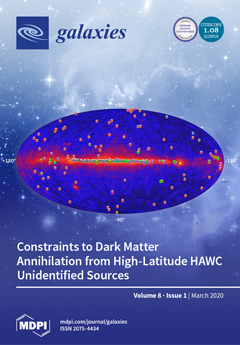The
CDM cosmological framework predicts the existence of thousands of subhalos in our own Galaxy not massive enough to retain baryons and become visible. Yet, some of them may outshine in gamma rays provided that the dark matter is made of weakly interacting massive particles (WIMPs), which would self-annihilate and would appear as unidentified gamma-ray sources (unIDs) in gamma-ray catalogs. Indeed, unIDs have proven to be competitive targets for dark matter searches with gamma rays. In this work, we focus on the three high-latitude (
) sources present in the 2HWC catalog of the High Altitude Water Cherenkov (HAWC) observatory with no clear associations at other wavelengths. Indeed, only one of these sources, 2HWC J1040+308, is found to be above the HAWC detection threshold when considering 760 days of data, i.e., a factor 1.5 more exposure time than in the original 2HWC catalog. Other gamma-ray instruments, such as Fermi-LAT or VERITAS at lower energies, do not detect the source. Also, this unID is reported as spatially extended, making it even more interesting in a dark matter search context. While waiting for more data that may shed further light on the nature of this source, we set competitive upper limits on the annihilation cross section by comparing this HAWC unID to expectations based on state-of-the-art N-body cosmological simulations of the Galactic subhalo population. We find these constraints to be particularly competitive for heavy WIMPs, i.e., masses above ∼25 (40) TeV in the case of the
(
) annihilation channel, reaching velocity-averaged cross section values of
(
) cm
·s
. Although far from testing the thermal relic cross section value, the obtained limits are independent and nicely complementary to those from radically different DM analyses and targets, demonstrating once again the high potential of this DM search approach.
Full article





